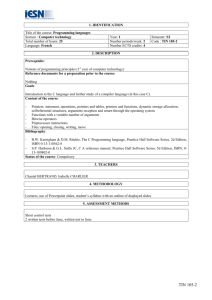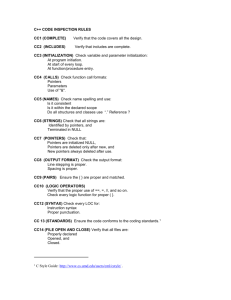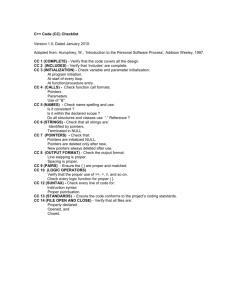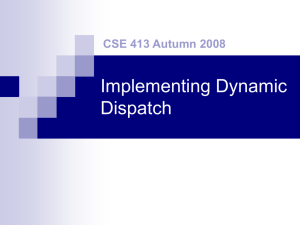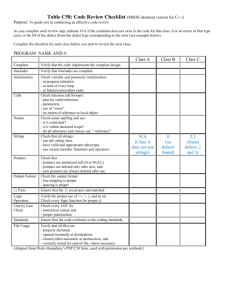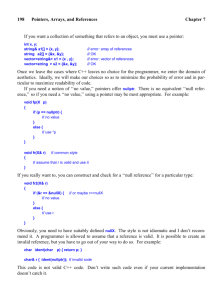CS61C - Lecture 13 - International Computer Institute
advertisement
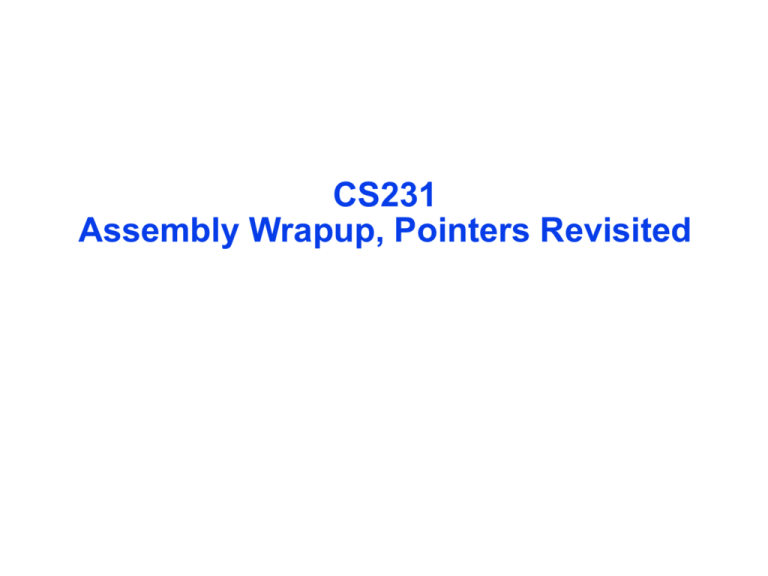
CS231
Assembly Wrapup, Pointers Revisited
Review (1/3)
C program: foo.c
Compiler
Assembly program: foo.s
Assembler
Object(mach lang module): foo.o
Linker
lib.o
Executable(mach lang pgm): a.out
Loader
Memory
Resolving References (1/2)
°Linker assumes first word of first text
segment is at address 0x00000000.
°Linker knows:
• length of each text and data segment
• ordering of text and data segments
°Linker calculates:
• absolute address of each label to be
jumped to (internal or external) and each
piece of data being referenced
Resolving References (2/2)
°To resolve references:
• search for reference (data or label) in all
symbol tables
• if not found, search library files (for
example, for printf)
• once absolute address is determined, fill
in the machine code appropriately
°Output of linker: executable file
containing text and data (plus header)
Symbol Table Entries
°Symbol Table
• Label
main:
Address (of label)
0x00000000 (0x004001f0 later)
loop:
0x00000018
str:
0x0 (0x10004000 later)
printf: 0x0 (0x00400260 later)
°Relocation Information (for external addr)
• Instr. Address Instr. Type
•0x00000040 HI16
Symbol
str
•0x00000044
LO16
str
•0x0000004c
jal
printf
Example: C Asm Obj Exe Run
•Remove pseudoinstructions, assign addresses
00
04
08
0c
10
14
18
1c
20
24
28
2c
addiu $29,$29,-32
sw
$31,20($29)
sw
$4, 32($29)
sw
$5, 36($29)
sw
$0, 24($29)
sw
$0, 28($29)
lw
$14, 28($29)
multu $14, $14
mflo
$15
lw
$24, 24($29)
addu $25,$24,$15
sw
$25, 24($29)
30
34
38
3c
40
44
48
4c
50
54
58
5c
addiu $8,$14, 1
sw
$8,28($29)
slti $1,$8, 101
bne
$1,$0, loop
lui
$4, hi.str
ori $4,$4,lo.str
lw
$5,24($29)
jal
printf
add
$2, $0, $0
lw
$31,20($29)
addiu $29,$29,32
jr
$31
Outline
°Signed vs. Unsigned MIPS Instructions
°Pseudoinstructions
°C case statement and MIPS code
°Multiply/Divide
°Problems with Pointers
°Multiply/Divide
°Faculty debate on pointers (if time
permits)
Loading, Storing bytes
°In addition to word data transfers
(lw, sw), MIPS has byte data transfers:
°load byte: lb
°store byte: sb
°same format as lw, sw
Loading, Storing bytes
°What do with other 24 bits in the 32 bit
register?
•lb: sign extends to fill upper 24 bits
°Suppose byte at 100 has value 0x0F,
byte at 200 has value 0xFF
lb $s0, $zero(100) ; $s0 = ??
lb $s1, $zero(200) ; $s1 = ??
°Multiple choice: $s0? $s1?
a) 15; b) 255; c) -1; d) -255; e) -15
Loading bytes
°Normally with characters don't want to
sign extend
°So MIPS instruction that doesn't sign
extend when loading bytes:
°load byte unsigned: lbu
Overflow in Arithmetic (1/2)
°Reminder: Overflow occurs when
there is a mistake in arithmetic due to
the limited precision in computers.
°Example (4-bit unsigned numbers):
+15
1111
+3
0011
+18
10010
• But we don’t have room for 5-bit
solution, so the solution would be 0010,
which is +2, which is wrong.
Overflow in Arithmetic (2/2)
°Some languages detect overflow (Ada),
some don’t (C)
°MIPS solution is 2 kinds of arithmetic
instructions to recognize 2 choices:
• add (add), add immediate (addi) and
subtract (sub) cause overflow to be detected
• add unsigned (addu), add immediate
unsigned (addiu) and subtract unsigned
(subu) do not cause overflow detection
°Compiler selects appropriate arithmetic
• MIPS C compilers produce addu, addiu,
subu
Unsigned Inequalities
°Just as unsigned arithmetic instructions:
addu, subu, addiu
(really "don't overflow" instructions)
°There are unsigned inequality instructions:
sltu, sltiu
but really do mean unsigned compare!
°0x80000000 < 0x7fffffff signed (slt, slti)
°0x80000000 > 0x7fffffff unsigned (sltu, sltiu)
Number Representation for I-format
op
6 bits
rs
rt
5 bits 5 bits
address/immediate
16 bits
°Loads, stores treat the address (0x8000 to
0x7FFF) as a 16-bit 2’s complement number:
-215 to 215-1 or -32768 to +32767 added to $rs
• Hence $gp set to 0x10001000 so can easily
address from 0x10000000 to 0x10001111
°Most immediates represent same values:
addi, addiu, slti, sltiu
(including “unsigned” instrs addiu,sltiu!)
°andi, ori consider immediate a
16-bit unsigned number:
0 to 216-1 , or 0 to 65535 (0x0000 to 0x1111)
True Assembly Language (1/3)
°Pseudoinstruction: A MIPS instruction
that doesn’t turn directly into a machine
language instruction.
°What happens with pseudoinstructions?
• They’re broken up by the assembler into
several “real” MIPS instructions.
• But what is a “real” MIPS instruction?
True Assembly Language (2/3)
°MAL (MIPS Assembly Language): the
set of instructions that a programmer
may use to code in MIPS; this includes
pseudoinstructions
°TAL (True Assembly Language): the set
of instructions that can actually get
translated into a single machine
language instruction (32-bit binary
string)
°A program must be converted from
MAL into TAL before it can be
translated into 1s and 0s.
True Assembly Language (3/3)
°Problem:
• When breaking up a pseudoinstruction, the
assembler will usually need to use an extra
register.
• If it uses any regular register, it’ll overwrite
whatever the program has put into it.
°Solution:
• Reserve a register ($1 or $at) that the
assembler will use when breaking up
pseudoinstructions.
• Since the assembler may use this at any
time, it’s not safe to code with it.
The C Switch Statement (1/3)
°Choose among four alternatives
depending on whether k has the value
0, 1, 2 or 3. Compile this C code:
switch (k) {
case 0: f=i+j; break; /* k=0*/
case 1: f=g+h; break; /* k=1*/
case 2: f=g–h; break; /* k=2*/
case 3: f=i–j; break; /* k=3*/
}
Example: The C Switch Statement (2/3)
°This is complicated, so simplify.
°Rewrite it as a chain of if-else
statements, which we already know
how to compile:
if(k==0) f=i+j;
else if(k==1) f=g+h;
else if(k==2) f=g–h;
else if(k==3) f=i–j;
°Use this mapping:
f: $s0, g: $s1, h: $s2, i: $s3,
j: $s4, k: $s5
Example: The C Switch Statement (3/3)
°Final compiled MIPS code:
bne
add
j
L1: addi
bne
add
j
L2: addi
bne
sub
j
L3: addi
bne
sub
Exit:
$s5,$0,L1
# branch k!=0
$s0,$s3,$s4
#k==0 so f=i+j
Exit # end of case so Exit
$t0,$s5,-1
# $t0=k-1
$t0,$0,L2
# branch k!=1
$s0,$s1,$s2 #k==1 so f=g+h
Exit # end of case so Exit
$t0,$s5,-2
# $t0=k-2
$t0,$0,L3
# branch k!=2
$s0,$s1,$s2 #k==2 so f=g-h
Exit # end of case so Exit
$t0,$s5,-3
# $t0=k-3
$t0,$0,Exit # branch k!=3
$s0,$s3,$s4 #k==3 so f=i-j
Common Problems with Pointers: Hilfinger
°1. Some people do not understand the
distinction between x = y and *x = *y
°2. Some simply haven't enough practice
in routine pointer-hacking, such as how
to splice an element into a list.
°3. Some do not understand the
distinction between struct Foo x; and
struct Foo *x;
°4. Some do not understand the effects of
p = &x and subsequent results of
assigning through dereferences of p, or
of deallocation of x.
Address vs. Value
°Fundamental concept of Comp. Sci.
°Even in Spreadsheets: select cell A1
for use in cell B1
1
2
A
B
100 100
°Do you want to put the address of cell
A1 in formula (=A1) or A1’s value
(100)?
°Difference? When change A1,
cell using address changes,
but not cell with old value
Address vs. Value in C
°Pointer: a variable that contains the
address of another variable
• HLL version of machine language address
°Why use Pointers?
• Sometimes only way to express computation
• Often more compact and efficient code
°Why not? (according to Eric Brewer)
• Huge source of bugs in real software,
perhaps the largest single source
1) Dangling reference (premature free)
2) Memory leaks (tardy free): can't have longrunning jobs without periodic restart of them
C Pointer Operators
°Suppose c has value 100, located in
memory at address 0x10000000
°Unary operator & gives address:
p = &c; gives address of c to p;
•p “points to” c
•p == 0x10000000
°Unary operator * gives value that pointer
points to: if p = &c; then
• “Dereferencing a pointer”
•* p == 100
Assembly Code to Implement Pointers
°deferencing data transfer in asm.
• ... = ... *p ...; load
(get value from location pointed to by p)
load word (lw) if int pointer,
load byte unsigned (lbu) if char pointer
•*p = ...;
store
(put value into location pointed to by p)
Assembly Code to Implement Pointers
°c is int, has value 100, in memory at
address 0x10000000, p in $a0, x in $s0
p = &c;
/* p gets 0x10000000 */
x = *p;
/* x gets 100 */
*p = 200; /* c gets 200 */
# p = &c; /* p gets 0x10000000 */
lui $a0,0x1000 # p = 0x10000000
# x = *p; /* x gets 100 */
lw $s0, 0($a0) # dereferencing p
# *p = 200; /* c gets 200 */
addi $t0,$0,200
sw
$t0, 0($a0) # dereferencing p
Registers and Pointers
°Registers do not have addresses
registers cannot be pointed to
cannot allocate a variable to a register
if it may have a pointer to it
C Pointer Declarations
°C requires pointers be declared to point
to particular kind of object
(int, char, ...)
°Why? Safety: fewer problems if cannot
point everywhere
°Also, need to know size to determine
appropriate data transfer instruction
°Also, enables pointer calculations
• Easy access to next object: p+1
• Or to i-th object: p+i
• Byte address? multiplies i by size of object
C vs. Asm
int strlen(char *s) {
char *p = s; /* p points to chars */
while (*p != ’\0’)
p++; /* points to next char */
return p - s; /* end - start */
}
mov $t0,$a0
lbu $t1,0($t0) /* derefence p */
beq $t1,$zero, Exit
Loop: addi $t0,$t0,1 /* p++ */
lbu $t1,0($t0) /* derefence p */
bne $t1,$zero, Loop
Exit: sub $v0,$t1,$a0
jr $ra
C pointer “arithmetic”
°What arithmetic OK for pointers?
• Add an integer to a pointer: p+i
• Subtract 2 pointers (in same array): p-s
• Comparing pointers (<, <=, ==, !=, >, >=)
• Comparing pointer to 0: p == 0
(0 used to indicate it points to nothing;
used for end of linked list)
°Everything else illegal
(adding 2 pointers, multiplying 2
pointers, add float to pointer, ...)
• Why? Makes no sense in a program
Common Pointer Use
°Array size n; want to access from 0 to
n-1, but test for exit by comparing to
address one element past the array
int a[10], *q, sum = 0;
...
p = &a[0]; q = &a[10];
while (p != q)
sum = sum + *p++;
• Is this legal?
°C defines that one element past end of
array must be a valid address, i.e., not
cause an bus error or address error
Common Pointer Mistakes
°Common error; Declare and write:
int *p;
*p = 10; /* WRONG */
• What address is in p? (NULL)
°C defines that memory location 0 must
not be a valid address for pointers
• NULL defined as 0 in <stdio.h>
Common Pointer Mistakes
°Copy pointers vs. values:
int *ip, *iq, a = 100, b = 200;
ip = &a; iq = &b;
*ip = *iq; /* what changed? */
ip = iq;
/* what changed? */
Pointers and Heap Allocated Storage
°Need pointers to point to malloc()
created storage
°What if free storage and still have
pointer to storage?
• “Dangling reference problem”
°What if don’t free storage?
• “Memory leak problem”
Multiple pointers to same object
°Multiple pointers to same object can
lead to mysterious behavior
°int *x, *y, a = 10, b;
...
y = & a;
...
x = y;
...
*x = 30;
...
/* no use of *y */
printf(“%d”, *y);
Java doesn’t have these pointer problems?
°Java has automatic garbage collection,
so only when last pointer to object
disappears, object is freed
°Point 4 above not a problem in Java:
“4. Some do not understand the effects of
p = &x and subsequent results of
assigning through dereferences of p,
or of deallocation of x.”
°What about 1, 2, 3,
according to Hilfinger?
Multiplication (1/3)
°Paper and pencil example (unsigned):
Multiplicand
Multiplier
1000
x1001
1000
0000
0000
+1000
01001000
• m bits x n bits = m + n bit product
Multiplication (2/3)
°In MIPS, we multiply registers, so:
• 32-bit value x 32-bit value = 64-bit value
°Syntax of Multiplication:
•mult register1, register2
• Multiplies 32-bit values in specified
registers and puts 64-bit product in
special result registers:
- puts upper half of product in hi
- puts lower half of product in lo
• hi and lo are 2 registers separate from
the 32 general purpose registers
Multiplication (3/3)
°Example:
• in C: a = b * c;
• in MIPS:
- let b be $s2; let c be $s3; and let a be $s0
and $s1 (since it may be up to 64 bits)
mult $s2,$s3 #
mfhi $s0
#
# product into
mflo $s1
#
# product into
b*c
upper half of
$s0
lower half of
$s1
°Note: Often, we only care about the
lower half of the product.
Division (1/3)
°Paper and pencil example (unsigned):
1001
Quotient
Divisor 1000|1001010
Dividend
-1000
10
101
1010
-1000
10 Remainder
(or Modulo result)
° Dividend = Quotient x Divisor + Remainder
Division (2/3)
°Syntax of Division:
•div
register1, register2
• Divides 32-bit values in register 1 by
32-bit value in register 2:
- puts remainder of division in hi
- puts quotient of division in lo
°Notice that this can be used to
implement both the C division
operator (/) and the C modulo
operator (%)
Division (3/3)
°Example:
• in C: a = c / d;
b = c % d;
• in MIPS:
- let a be $s0; let b be $s1; let c be $s2; and
let d be $s3
div $s2,$s3
mflo $s0
mfhi $s1
# lo=c/d, hi=c%d
# get quotient
# get remainder
More Overflow Instructions
°In addition, MIPS has versions for
these two arithmetic instructions
which do not detect overflow:
multu
divu
°Also produces unsigned product,
quotient, remainder
Common Problems with Pointers: Brewer
°1) heap-based memory allocation
(malloc/free in C or new/delete in C++)
is a huge source of bugs in real
software, perhaps the largest single
source. The worse problem is the
dangling reference (premature free), but
the lesser one, memory leaks, mean
that you can't have long-running jobs
without restarting them periodically
Common Problems with Pointers: Brewer
°2) aliasing: two pointers may have
different names but point to the same
value. This is really the more
fundamental problem of pass by
reference (i.e., pointers): people
normally assume that they are the only
one modifying the an object
°This is often not true for pointers -there may be other pointers and thus
other modifiers to your object.
Aliasing is the special case where you
have both of the pointers...
Common Problems with Pointers: Brewer
°In general, pointers tend to make it
unclear if you are sharing an object or
not, and whether you can modify it or
not. If I pass you a copy, then it is
yours alone and you can modify it if
you like. The ambiguity of a reference
is bad; particularly for return values
such as getting an element from a set - is the element a copy or the master
version, or equivalently do all callers
get the same pointer for the same
element or do they get a copy. If it is a
copy, where did the storage come
from and who should deallocate it?
Java vs. C. vs. C++ Semantics?
1. The semantics of pointers in Java, C,
and C++ are IDENTICAL. The
difference is in what Java lacks: it
does not allow pointers to variables,
fields, or array elements. Since Java
has no pointers to array elements, it
has no "pointer arithmetic" in the C
sense (a bad term, really, since it only
means the ability to refer to
neighboring array locations).
°When considering what Java, C, and
C++ have in common, the semantics
are the same.
Java pointer is different from meaning in C?
°2. The meaning of "pointer semantics"
is that after
y.foo = 3;
x = y;
x.foo += 1;
°y.foo is 4, whereas after
x = z;
x.foo += 1;
°y and y.foo are unaffected.
°This is true in Java, as it is true in
C/C++ (except for their use of ->
instead of '.').
Java vs. C pass by reference?
°3. NOTHING is passed by reference in
Java, just as nothing is passed by
reference in C. A parameter is
"passed by reference” when
assignments to a parameter within the
body means assignment to the actual
value. In Java and legal C, for a local
variable x (whose address is never
taken) the initial and final values of x
before and after
…x; … f(x);
… x; …
°are identical, which is the definition of
"pass by value”.
What about Arrays, Prof. Hilfinger?
°3. There is a common misstatement that
"arrays are passed by reference in C".
The language specification is quite clear,
however: arrays are not passed in C at all.
• (If you want to “pass an array” you must
pass a pointer to the array, since you can’t
pass an array at all)
°The semantics are really very clean---ALL
values, whether primitive or reference--obey EXACTLY the same rule. We really
HAVE to refrain from saying that "objects
are passed by reference", since students
have a hard enough time understanding
that f(x) can't reassign x as it is.
“And in Conclusion..” 1/2
°Pointer is high level language version of
address
• Powerful, dangerous concept
°Like goto, with self-imposed discipline can
achieve clarity and simplicity
• Also can cause difficult to fix bugs
°C supports pointers, pointer arithmetic
°Java structure pointers have many of the
same potential problems!
“And in Conclusion..” 2/2
°MIPS Signed v. Unsigned "overloaded" term
• Do/Don't sign extend (lb, lbu)
• Don't overflow (addu, addiu, subu, multu, divu)
• Do signed/unsigned compare (slt,slti/sltu,sltiu)
• Immediate sign extension independent of term
(andi, ori zero extend; rest sign extend)
°Assembler uses $at to turn MAL into TAL
°Compiler transitions between levels of
abstraction
